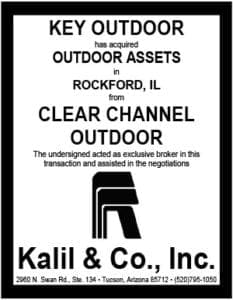 Jim Spaeth is a Partner at Sequent Partners, a brand and media metrics and analytics consulting firm. Spaeth spoke on out of home advertising return on investment (“ROI”) models at the LookOut2017 convention last week. Insider asked Spaeth to expand on his talk.
Jim Spaeth is a Partner at Sequent Partners, a brand and media metrics and analytics consulting firm. Spaeth spoke on out of home advertising return on investment (“ROI”) models at the LookOut2017 convention last week. Insider asked Spaeth to expand on his talk.
Jim, how did you get involved in the out of home advertising business?
I’ve had some involvement with OOH since the earlier days of my career at Y&R. I helped develop a reach & frequency system for the TAB back then. Later, when I had the media research responsibility at a leading advertiser, we ran a major in-market test that demonstrated the power of OOH. So I’ve always understood how well the medium works. Early in the life of Sequent Partners, we helped TAB set a course for Eyes-On measurement. More recently, we helped them develop the roadmap that Kym Frank is so effectively following at GeoPath. We just want to see OOH get its just rewards!
You said in your talk that 70% of the return on investment on out of home advertising comes from creative. Where does this statistic come from?
We have done a dozen studies of ROI measurement over the past 5 years. These often involve gathering information from the modeling providers. They have all, very consistently, said that the creative is responsible for between 2/3 and 3/4 of a campaign’s ROI. These companies work for all of the leading advertisers and, collectively, have experience with hundreds of brands over many decades. Last year the Advertising Research Foundation did a meta-analysis of hundreds of modeling cases and declared that creative can be responsible for as much as 80% of a campaign’s ROI.
Do out of home companies pay enough attention to creative?
OOH companies understand what great creative looks like. The OAAA has addressed this issue consistently over the years. I’d like to see more use of ad pretesting to ensure that every execution that goes up is effective. But, there’s a time and money issue. The industry could benefit from a quick an inexpensive testing method. Maybe we should then about that next!
You also referred to the fact that advertising generates 8-10% of a typical company’s sales. Can you expand on this?
We are all so focused on advertising, that we forget that there are other elements of the marketing mix and factors beyond marketing that impact sales. The biggest is called “the baseline.” That’s just jargon for consumers’ habitual buying behavior. True brand loyalty in some cases, pure habit in others. If I had to rethink every product I buy overtime I buy it, I’d go nuts. So I just buy the same one over and over, if Im happy with it. Unless an ad changes my mind … or a sale, or a coupon, or a recommendation from a friend, or something else. That reality is reflected in the marketing mix models. The baseline (consumer habit or loyalty) accounts for the vasty majority of sales — 60% – 80% in CPG. Then distribution (product availability), price, promotion and other in-store factors are the next biggest determinant of brand purchase. Advertising comes in after all of these sales drivers. That doesn’t make advertising’s contribution unimportant. Excellent creative is still the most profitable way to drive sales. But it’s a rare commodity.
[wpforms id=”9787″]
Paid Advertisement

















